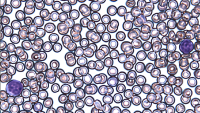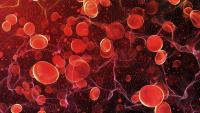About Leukemia
Make an Appointment
Our team of dedicated access representatives is here to help you make an appointment with the specialists that you need.
Leukemia is a cancer of the blood cells. Blood is made of three types of cells:
- White blood cells that fight infection
- Red blood cells that carry oxygen from the lungs to the rest of the body
- Platelets that help the blood clot and stop bleeding
These cells are made in the bone marrow, a spongy area in the center of the bones.
Once these cells mature, they leave the marrow and start circulating through the bloodstream.
If you have leukemia, the blueprint or genetic material in your blood cells gets damaged. That makes your bone marrow produce too many of one kind of cell, usually white blood cells. These cells get stuck at an early stage of development called blasts. The blasts grow rapidly and crowd your bone marrow so it can’t produce normal blood cells.
Because leukemia is a disease of your blood and bone marrow, it can travel to other parts of your body, including your liver, spleen, lymph nodes, spleen and skin.
The American Cancer Society estimates that about 66,000 people in the US will be diagnosed with leukemia each year.
Leukemia types
Leukemias are classified by how fast they progress and by the type of cell involved.
Speed
Acute leukemia
Immature white blood cells, called blasts, grow too quickly. You can have severe symptoms right away.
Chronic leukemia
The blood cancer cells grow slower and symptoms might not appear for years.
Types of cells
Myeloid leukemia
Myeloid leukemia develops in white blood cells and can affect infection-fighting cells such as neutrophils and monocytes. These cells help fight bacterial and fungal infections.
Lymphocytic leukemia
Lymphocytic leukemia develops in immature stem cells that grow into B lymphocytes, T lymphocytes or natural killer (NK) cells. Each of these cell types produces antibodies or other substances to fight infections.
Leukemia classifications
Acute myeloid leukemia
AML affects about 22,000 adults each year. People are usually diagnosed after age 45. AML is most common in people after age 65. Children rarely get this type of leukemia.
AML has many subtypes, determined by chromosome problems and changes in genes, which are called mutations. Your AML’s subtype helps your doctor know what type of treatment you’ll have and understand if your outlook is favorable or unfavorable.
Acute lymphoblastic leukemia
ALL affects about 6,000 people each year. It’s most common in children under 5 and adults over 65. ALL is very rare, accounting for less than 1% of all cancers in the United States.
Other diseases that involve genetic changes seem to increase a person’s risk of developing ALL. These include Down syndrome, Klinefelter syndrome, Fanconi anemia, Bloom syndrome, Ataxia-telangiectasia, and neurofibromatosis.
Children with ALL may respond better to treatment than adults because their leukemia cells are more sensitive to treatment and because younger patients can often handle more aggressive treatments.
Chronic lymphocytic leukemia
CLL accounts for one-third of all new cases of leukemia every year. About 20,000 older adults—with an average age of diagnosis around 70 —are affected each year. CLL is rare in people under 40 and extremely rare in children. In CLL, changes to the leukemic B cells cause overproduction of lymphocytes.
CLL usually progresses slowly. You might not have symptoms for a long time. In some people, though, CLL can be aggressive and progress faster. In this case you need immediate treatment (link to leukemia treatments page). Columbia performs advanced testing when you’re diagnosed that helps predict the course of your disease and guides our treatment plan.
Chronic myeloid leukemia
About 9,500 people are diagnosed with CML every year. About 15% of all new cases of leukemia are chronic myeloid leukemia. Almost half of all CML cases are diagnosed at 65 or older. CML rarely affects children.
In CML, two chromosomes (9 and 22) swap information during cell division. This translocation causes a shortened version of chromosome 22. This is called the Philadelphia chromosome. The DNA swap creates an oncogene called BCR-ABL. This gene produces a protein that makes the bone marrow create too many myeloid white blood cells.
DNA changes related to CML occur during the person's lifetime and are not inherited.
CML is classified in three phases: chronic, accelerated, and blast phase. This classification is based on the percentage of immature cells (blasts) in your bone marrow and other characteristics. This classification helps your doctor choose the best treatment for you when you’re diagnosed.
Risk factors
If you have been diagnosed with leukemia, remember that it’s never your fault. Risk factors for leukemia are mostly out of your control. They include:
- Previous cancer treatment. People who’ve had both chemotherapy and radiation for another cancer have the highest risk of leukemia.
- Specific blood disorders. People with myelodysplastic syndromes have an increased risk of leukemia.
- Environmental causes. Exposure to high levels of radiation, to benzene, and to some chemicals used in the petroleum and rubber industries have been linked to leukemia.
- Age. Most people with leukemia are over 60. Although you can develop it at any time of life, most types are rarely diagnosed in people under 40. Children are most typically diagnosed with acute lymphocytic leukemia (ALL).
- Gender. Leukemia is generally more common in men than women.
- Smoking. The use of cigarettes is a known risk factor for acute myeloid leukemia.
- Family history. You are at higher risk of developing leukemia if other family members have had it.
Signs & symptoms
People are often diagnosed with leukemia when their doctor finds abnormal blood counts during a routine physical exam. The symptoms depend on the type of blood cell that’s being affected.
- Low red blood cells lead to anemia: Headaches, lightheadedness, shortness of breath, pallor and fatigue.
- Low white blood cells cause an increased risk of infections that are recurrent and difficult to treat
- Low platelets cause bruising, frequent nosebleeds, and red spots (petechiae) on the skin.
Acute leukemias can affect your brain and spinal cord, so you might have headaches, blurred vision, double vision, vomiting, or confusion.
Common symptoms
- Fevers and night sweats
- Infections
- Shortness of breath
- Easy bruising
- Bleeding
- Ongoing exhaustion or fatigue
- General weakness
- Weight loss
- Joint pain
- Swollen or tender lymph nodes
- Increased size of the liver or spleen
- Swollen or bleeding gums
Diagnosis
Many people are diagnosed with leukemia during a doctor’s exam, when they find that their spleen, liver, or lymph nodes are enlarged. To determine if you have leukemia, you may have a number of these tests:
- A complete blood count (CBC) gives your doctor a profile of your blood. It shows whether your bone marrow is making fewer white cells, red cells, platelets, or all three. If you’re anemic, additional tests can help determine if it’s caused by leukemia or iron, vitamin B12, or folate deficiencies.
- Bone marrow aspiration or biopsy uses a needle to sample marrow fluid (aspiration) or solid bone marrow tissue (core biopsy). This sampling usually happens at the back of your hip after numbing the area. A pathologist will then examine the cells under a microscope for abnormalities and to rule out other types of cancer.
- Spinal tap, also called a lumbar puncture, draws a small amount of cerebrospinal fluid from your spine. A pathologist will examine the fluid under a microscope to look for infection, cancer cells, or other problems.
- AML typing tests determine the extent of your cancer and classify it into a more specific AML type.
- Other tests, including cytogenetic studies, which look for chromosomal changes in your cells, immunohistochemistry studies that use antibodies to distinguish types of cancer cells, flow cytometry that uses a laser beam to look at proteins on cells’ surface, and molecular genetic studies that determine cancer cells’ specific traits.





